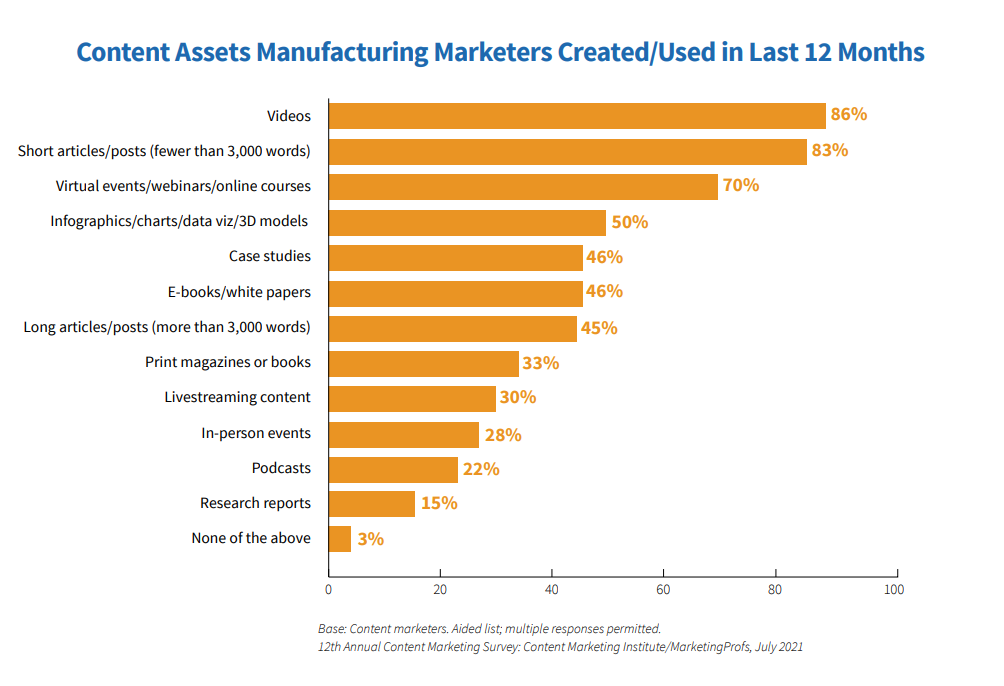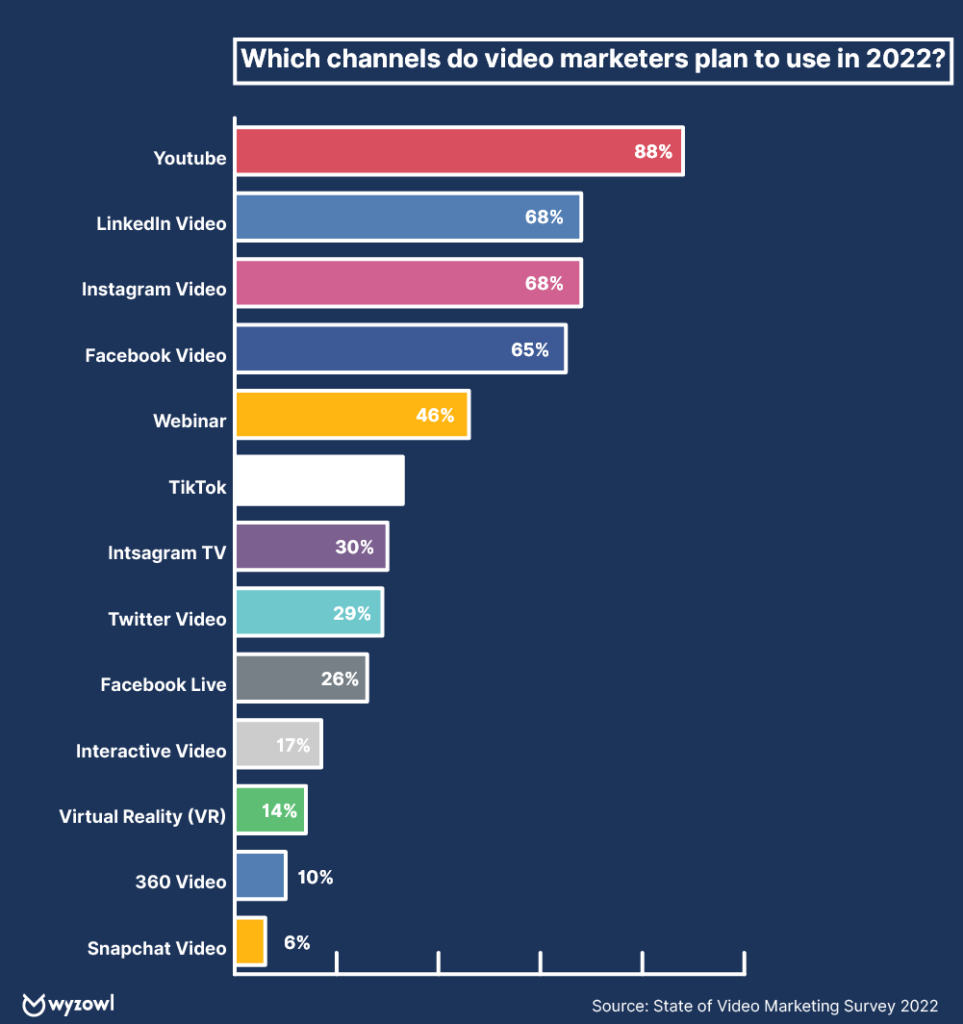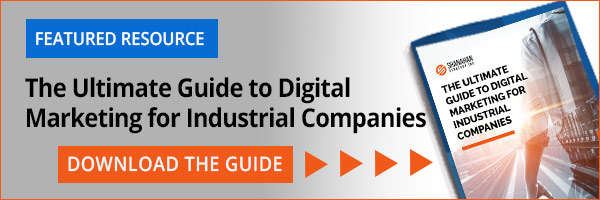While content marketing for manufacturers has always been a challenge, it’s even more complicated in post-pandemic business landscapes where buyers have more information at their fingertips than ever before. As a manufacturer looking to compete you need to develop content that provides value to customers, reaches new prospects, and differentiates your company from others.
In this article, you’ll discover why manufacturers need a content marketing strategy and the top ways to boost your ongoing inbound efforts. After all, 51% of manufacturers say their biggest challenge is creating valuable content instead of sales-orientated materials and overcoming traditional mindsets.
Ready to learn more? Let’s dive in!
Key Takeaways:
- Content marketing helps manufacturers establish brand authority and leadership in their industry
- Since the pandemic, more manufacturers have utilized content marketing to reach their audience instead of relying on traditional marketing techniques
- Cross-functional leadership alignment and developing key performance indicators is the best way to ensure your curation and distribution plan is successful
Why Content Marketing for Manufacturers is Important
Since the pandemic, manufacturers have shifted their marketing budget from traditional face-to-face tactics like tradeshows and conferences to content creation in the digital world. Content marketing gives manufacturers the opportunity to build trust, improve conversions with potential prospects, and provide meaningful answers to existing customers to strengthen brand loyalty.
With 80% of marketers making content a priority moving forward, it also lets you educate your audience on why you’re the preferred company and provide thought leadership to your industry at large. Here are a few benefits you can expect from developing content:
- Longer audience retention with positive experiences that capture their attention
- Improved traction on channels like email, social media, and organic search engine rankings
- Increased brand awareness, quality lead generation, and conversion efforts as you build better authority
- Saved budget overtime with more evergreen content development
What Makes Manufacturing Content Marketing Different?
While content marketing is a universal tactic that any industry can use, manufacturing companies experience added complexities. Not only do 16% of manufacturers rarely differentiate content from their competition, but it’s also a struggle to create content for different audience role functions and funnel stages.
Keep in mind these other differences when developing manufacturing content:
- Complicated products: Your audience might need professional expertise to understand and use your products
- Audience expectations: Manufacturing prospects want to learn from experts and trust your company before making a purchase decision
- Niche industries: Most likely, your business specializes in a highly specific niche with a smaller target audience and limited market data
- Long buying cycles: Businesses often have lengthy buying cycles and content marketing can be used to help shorten the process with informative resources and guides
Types of Effective Content That Manufacturers Should Develop
When developing your manufacturing content, you need to consider the top, middle, and bottom-funnel stages to deliver relevant material to your audience depending on their unique customer journey. To be successful, create consistent content through every step to meet your prospect’s needs and push them to the next phase.
If you’re stuck in a loop of only creating sales enablement materials, here are a few ideas to help you get started:
- Top funnel content: Blog posts, simple ebooks, industry research, white papers, and social media
- Middle funnel content: Comparison guides, industry-focused material, and case studies or video testimonials
- Bottom funnel content: Product videos, spec sheets, brochures, and industry calculators or technology
Creating quality content is essential for your overall success. Of course, the content you make also depends on your buyer personas and customer preferences. For example, if you notice more engagement with industry research than ebooks in the top funnel, you’ll want to focus on the content that produces better results.

11 Tips for Manufacturers to Improve Content Marketing Efforts
If you have a lean marketing team, developing educational content might not be a priority against the endless sales requests. You also might be fighting against a leadership mentality that still believes in traditional marketing like tradeshows, print, or industry publications instead of digital distribution.
However, many manufacturers state that the pandemic forced their teams to focus on content marketing since the sales team could no longer travel. What does this mean for you? Developing content is a competitive differentiator that not only helps elevate your company but also gives the sales organization better touchpoints to their accounts.
Whether you’ve grown traction with B2B content marketing or want to get started, here are a few tips to avoid falling into old habits:
1. Develop a Thought Leadership Strategy with your Executive Team
If you struggle with leadership buy-in, it’s essential to include them in the development and execution process. For starters, share your strategy with them and clearly lay out your objectives and hypothesis to prove performance success. If you meet your goals, it’s a great way to justify future budgets and resources.
Since your leadership is most likely more experienced in your industry, you’ll also want to create a go-to marketing plan to get them involved in thought leadership content distribution. For example, develop copy for executives to post on their LinkedIn or ghostwrite an insider blog post. Not only will this get them involved in customer engagement, but it also helps boost their own brand identity in your industry.
2. Focus on a Specific Niche Relevant to Your Audience
Your content should not be random and unpredictable. Start by focusing on your target niche and identifying a handful of overarching topics you want to focus on when developing new content. Think of these core topics as the “pillars” of your website.
From there, you can dive into each overarching category and develop a list of subtopics that fall under your pillar topics. Your subtopics should closely relate to your main topics, creating more focus, organization, and clarity on your website.
3. Align Sales and Marketing Organizations
About 81% of sales executives agree that content utilization is a top priority to improve within their organization. Sales and marketing alignment is essential to develop relevant content and ensure that your content is valuable to the end-user. After all, your sales organization has the most insight into your customer’s challenges, pain points, and gaps – giving you essential information to customize future materials.
While many sales teams utilized more content during the pandemic, you should consider meeting with them monthly to determine what content is working and what might need a refresh. You can also use this time to pitch new ideas, share performance, learn industry trends, and hear valuable customer feedback to help future content development cycles.
4. Determine an Approved Content Marketing Budget
To remain competitive, you need to request a specific content marketing budget. In fact, 69% of marketers plan on increasing spending on video, 61% in events, 57% in owned media, and 55% in paid media. You especially want to pay attention to videos since more consumers consume and prefer visual content instead of written.
Consider investing 25% to 30% of your budget to content marketing needs as a general rule of thumb. Once you have a budget established, you need to set allocations per channel and campaign to help you stay on track. It’s important to note that different types of content have varying price tags — think videos and infographics vs. blog or social media posts. Here are a few questions to ask yourself to determine the proper allocations:
- What are your main objectives?
- How will you distribute the content, and how often?
- What tools or resources do you need to execute the campaign?
- How will you report on the content’s success?

5. Use Headlines that Match the Reader’s Interests
Your headline is the key to whether your reader will continue reading or not. Make sure it grabs them and is intriguing enough to make them interested. To pick an attention-grabbing headline, know your audience.
If you’re marketing a product or service for industrial for companies, make sure the topic has a decent search volume for your industry and that it’s relevant to your prospective buyers.
The headline of an article or piece of content can make or break the article. If the headline doesn’t entice enough to get readers to click, your article won’t serve your audience and you’re wasting precious resources. Action verbs and powerful adjectives keep your headline short and believable.
6. Break Up Text into Digestible Chunks
A common way to make longer articles easier to read is to divide the text into defined sections, then use a heading for each section. Make sure your headings include relevant keywords to increase your search engine rankings. It’s also helpful to weave in different types of content to create interest. For example, use bullet points and quotes to break up the text.
Why is it so important to use sections? Beyond better search engine rankings, it will help you retain readers. People are turned off by a page filled with words with no white space to rest their eyes. Keep your paragraphs short, around three sentences each. Comb through your copy, eliminate excess words and stay away from the “fluff” and your message will be concise and powerful.
7. Use Visuals
Don’t limit yourself to only words. Visuals, including videos, are powerful ways to engage and connect with your audience and make your content more digestible and easier on the eyes. Graphs, charts, and photos are the obvious choice, but you can also add infographics, illustrations, videos, charts, or other visual aids to help your readers understand and retain information easier.
In a world where everyone gets information from a smartphone or a tablet, and they’re bombarded by all sorts of information from the moment they wake up until the moment they go to bed, visual content is essential to making an impact. It’s also another way to break up blocks of text to improve readability.
8. Answer the Most Common Questions Related to Your Topic
If you answer the questions your target audience is asking, they’ll keep coming back for more. Use sites like AnswerthePublic.com and type in keywords related to your topic or industry. The site will return a list of common questions people ask about that keyword. Write content that answers the relevant questions people ask about that keyword to gain traffic and customers. By answering these questions, you’ll develop a reputation as an authority on your subject matter and that’s good for future website traffic and business.
9. Create Superb Content
Are you spending enough time on content creation? Are your writers and editors industry experts? Do they produce excellent content? Are your messaging and tone consistent? Do you go in-depth and offer creative resources that target your audience? Is your content better than your competitors’?
Make sure all your content addresses the following:
- In-Depth – Write in-depth content that digs into the details without being overwhelming.
- Proofed – Make sure all your content is proofed by multiple people.
- Factual – Your content should be based on facts or research that you can backed up.
- Persona-Focused – Your content should be focused on a specific persona that you’re targeting.
- Original – All content you create should be as close to 100% original as possible. Use various reputable sources to compile your research, and incorporate your perspective and brand personality in every piece.
- Optimized – Before you begin, topics should be researched and optimized for strategic topics and keywords, subheadings, images, links, and more.
10. Create a Strong Content Distribution Plan
Even if you create the most valuable and engaging content, you need a distribution plan for your audience to discover it. Content distribution is the tactic of publishing, sharing, and promoting your content on your key channels. This not only helps your content reach your ideal prospect, but it also gives you the insight to determine where to optimize your strategy to improve results.
A few additional reasons why you need a distribution plan include:
- The improvement of your content beyond the curation process
- To help align your cross-functional teams on how to share content and where
- It sets benchmark goals to determine performance against multiple channels
You can distribute your content on either owned channels, like your blog or social media profiles, or earned content channels, like third-party blogs or forums. While you also need to research your target audience, experts recommend taking a more holistic approach to maximize your reach and conversions.
11. Measure Content Performance Consistently
Your content marketing return on investment (ROI) is essential to highlight success and effectively attribute leads back to specific campaigns. If you want to be successful, you need to outline goals leveraging real-time data and set clear expectations for your teams.
Depending on the content type and channel, there are four key metrics categories to track your campaigns:
- User behavior: Pageviews, users, average time on page, bounce rate, pages per session, and traffic sources
- Engagement: Likes, shares, comments, mentions, and re-publications
- SEO: Organic traffic, backlinks, dwell time, and keyword rankings
- Revenue: Conversions, leads nurtured, new leads, and cost per acquisition
Beyond these metrics, you’ll also want to monitor your channel metrics and insights to learn where you can improve in the future to drive more audience engagement.
Give Your Customers More Value with Content Marketing
Content marketing allows manufacturers to build authority, educate prospects, and grow their active customer base. Whether you’re new to content marketing or ready to kick it up a notch, developing a strategy to plan how you will curate, distribute, and measure your content is essential to your overall success.
Ready to boost your content marketing strategy? Get started with Shanahan Strategy Inc.

